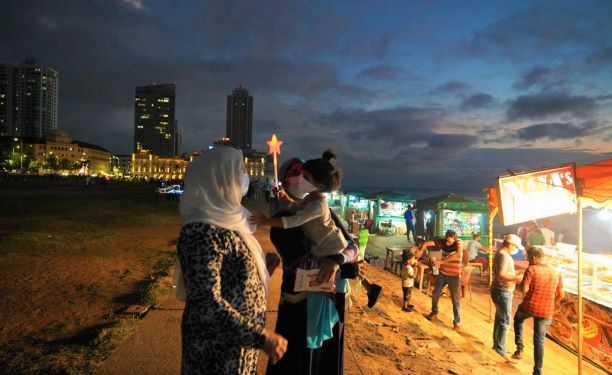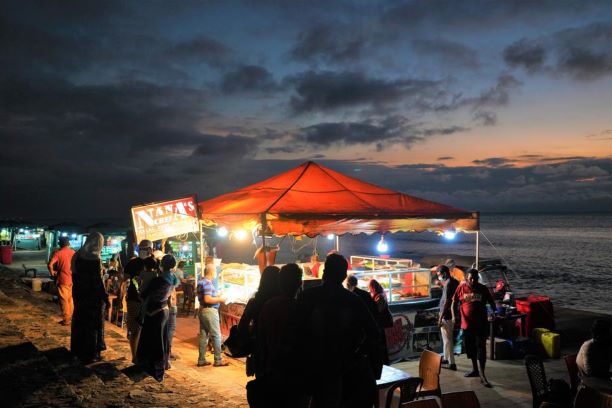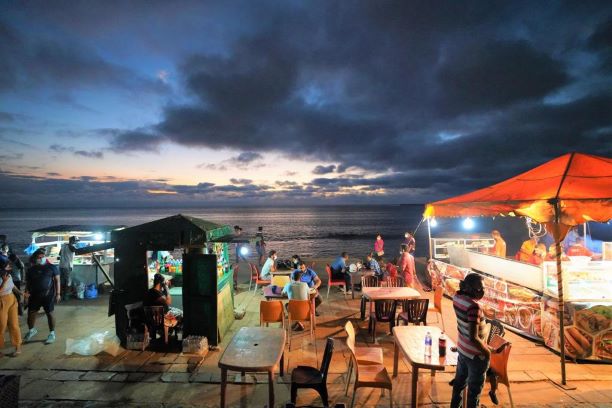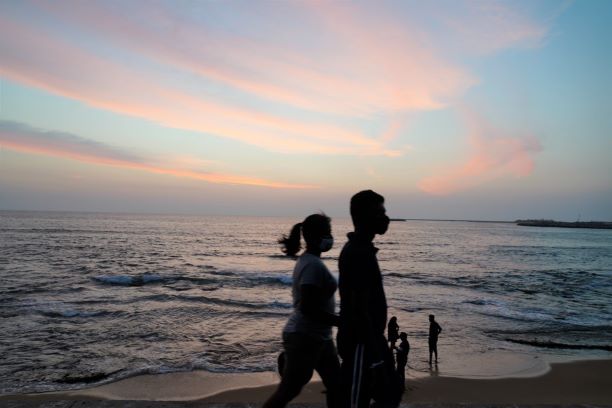Photo Feature: Galle Face promenade comes to life at dusk
Posted on December 31st, 2020
Courtesy NewsIn.Asia

Colombo, December 31: One of the most attractive landmarks in the Sri Lankan capital Colombo, is the Galle Face Green, a 5-hectare open sea-side field with a promenade running along the water’s edge.
Flanked by the colonial-era Galle Face Hotel, built in 1864, in the south, and the more recently put up Kingsbury Hotel and the up and coming Colombo Port City in the north, Galle Face Green is in every sense a part of busy downtown Colombo.
And yet, it is serves as a retreat, offering office-goers and others from the city relief from stress.
In the mornings, walkers and joggers occupy the space. As the day unfolds, couples and love birds playing truant from their schools or workplaces occupy the benches with umbrellas sheltering them from the hot sun and prying eyes.

In the evenings, the couples disappear to yield place to children, walkers and joggers. The vast ground is used by children to play, itinerant vendors to sell their wares and food stalls owners to cater to the taste buds of the hoi polloi.
Families cooped up in tiny overcrowded houses and flats in the city during the day, and desperate for some fresh air and tasty street food, pour into Galle Face Green as the sun set in a riot of color.
In the kite flying season, kite sellers pop up, sometimes displaying exotic Chinese kites to the delight of the kids.
A virtually deserted place during the day, Galle Face springs to life in the evenings with brightly lit shops fitted with loudspeakers blaring music to attract customers.
Gall Face Green was an colorless marshy land between the Arabia Sea in the West and miles and miles of coconut plantations and cinnamon gardens in the East, before it was cleared by the Dutch for a military purpose. Located in the Fort in the North, the Dutch cleared the jungle to secure a clear line of fire for their cannons.

When the British took over from the Dutch in 1798, and there were no challengers to their hegemony, the idea of using the cleared land as a recreational area germinated.
However, it was not until mid-19th.Century that the ground was actually turned into a recreational place for British officials, soldiers and businessmen and their families. The Galle Face Green became a venue for horse racing, cricket, rugby, and polo matches and equestrian sports.
Horse races were held here as early as the 1820s, when Sir Edward Barnes was Governor. In fact, the area was then known as the Colpetty Race Course. Horse races were held there until 1893 when racing was shifted to the specially constructed Colombo Racecourse further South.
It was in 1859 that Governor Henry George Ward created the promenade on the sea side. According to a city historian, the promenade was meant to be for ladies and gentlemen to unfold their grace and haughtiness, a place for soldiers on horseback to show off their latest accoutrements, a scene for flirtation and gossip, political and social.”
In 1879, when British expatriates introduced golf to Ceylon, Galle Face Green became the golf course. The Colombo Golf Club was inaugurated there on March 13, 1880 , though there was neither a proper golf course nor a club house. The club was shifted to the present premises in Borella after Galle Face Green got crowded with people seeking space for a variety of activities including cricket, rugby tennis and other sports.

It was at the place where the Taj Samudra Hotel is located now, where the celebrated cricket contest between Royal College and St.Thomas College was first played in July 1879. It is said that the two teams had to row across the Beira Lake to reach Galle Face Green. Colombo Academy, as Royal College was then called, won the inaugural encounter by 56 runs.
Two historic incidents took place on Galle Face Green. The first was on August 5, 1942 during World War II. 125 Japanese bombers, under Mitsuo Fuchida, the hero of Pearl Harbour, were targeting Colombo Harbor thinking that the British Eastern Fleet was anchored there.
British Hurricanes fighters based in the secret airfield located in the Colombo Race Course opposite Royal College, took off to intercept the Japanese fighters and drove them away, though not before the raiders had sunk HMS Dorsetshire and HMS Cornwall.
One of the Hurricane pilots was hit by Japanese fire and had to force land his blazing aircraft on Gall Face Green to the utter shock of the people there. The pilot was extricated and rushed to the Galle Face Hotel. Shaken, he asked for whiskey, but since it was 8.30 in the morning and the bar was not open, a bearer rushed to get what he knew was the next best thing – a glass of plain tea, cold tea to be precise.

Galle Face Green was also linked to the death of Sri Lanka’s First Prime Minister and the Father of the Nation, D.S.Senanayake. On the morning of Friday, 21 March 1952, Senanayake was on his customary pre-breakfast ride on Galle Face Green, a short distance from his official residence, the Temple Trees. He was riding one of his favorite horses Chitra, a mare belonging to the mounted police. Accompanying him on that day was Sir Richard Aluwihare, the Inspector General Police; G.G. Ponnambalam, a cabinet minister, and police Inspector Eddie Grey. The Prime Minister’s horse suddenly broke into a gallop from a canter throwing Prime Minister off.
He was rushed to a nursing home where for the next thirty-two hours he was unconscious. It was believed that he fell off the horse because he had suffered a stroke. The best of local medical local could not save Senanayake who died on 22 March 1952.
Unfortunately now, the latest international scourge, the coronavirus has caught with Galle Face Green. Rapid Antigen Tests conducted on vendors there recently, found nine of them to be COVID-19 positive.
(Photos: Tang Lu/Xinhua. Text: newsin.asia)
January 15th, 2021 at 1:59 pm
Thanks to the colonial governor we all have a beautiful pleasant place to enjoy. Our balu kings never did such things to the humble people, not even a public toilet.We must rename it as Havelock’s park.
January 15th, 2021 at 10:57 pm
Yes, made by Colombuns for Colombuns with the money earned by millions of our women toiling in distant lands but unable to return to the land (prevented by our own so called Ranawiruwos) they were born.
Yes, their stars, and hopes, are rising on the horizons of setting sun as shown in the topmost picture and note the symbolism.
But that will be a dream only as long as we have those farmers who are trying to save their lands from all encroachers (all sorts of creatures including the two legged ones) are there and they also produce children.